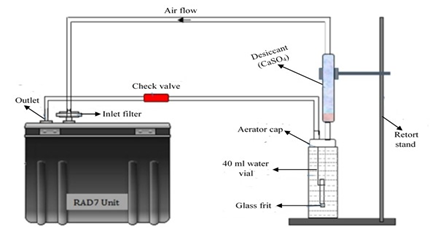Annual Effective Dose and Excess Lifetime Cancer Risk due to Ingestion and Inhalation of Radon in Groundwater of Bosso Community Minna, North-Central Nigeria
Keywords:
222Rn concentration, groundwater, Bosso community, RAD-7 radon detector, Committed effective dose, ELCR, NigeriaAbstract
Radon in potable water has become an issue of public health concern, especially when consumed or used directly from source for domestic purposes without any pre-treatment. In this study, 222Rn concentration in 22 water samples collected from 2 groundwater sources (open wells, 12 samples and boreholes, 10 samples) in Bosso town, North central Nigeria were measured using Durridge RAD-7 radon detector with RAD-H2O accessories. 222Rn concentrations in open wells varied from 2.1±0.7 to 27.9±2.5 Bq L-1 with a mean of 10.2±1.5 Bq L-1, while that in boreholes ranged from 2.8±1.1 to 39.2±1.5 Bq L-1 with a mean value of 14.3±1.7 Bq L-1. These values are lower than the 100 Bq L-1 upper limit proposed by the European Union Commission, above which any practical intervention may be necessary. Mean annual committed effective dose to adults, children and infants from ingestion of water were 74.64, 71.58 and 53.17 \muSv y-1 respectively for the open wells and 104.24, 99.96 and 74.26 \muSv y-1 respectively for borehole water samples. Mean whole body dose due to ingestion and inhalation of waterborne radon from open wells and boreholes are 27.56 and 38.48 \muSv y-1 respectively, which are below the reference level of 0.1 mSv y-1 for potable water recommended by the World Health Organization for public safety. The excess lifetime cancer risk were 0.10 × 10-3 for the open wells and 0.13 × 10-3 for the boreholes, which are lower than the world safety limit 0.29 × 10-3. Water from the two groundwater sources investigated is therefore fit for consumption and other domestic usage from the point of view of radiation protection.

Published
How to Cite
Issue
Section
Copyright (c) 2023 Matthew Tikpangi Kolo, Oyeleke Olarinoye, Simon Olonkwoh Salihu, Hyginus Anayo Ugwuanyi, Paul Onuche, Opeyemi Falade, Nwachukwu Chibueze

This work is licensed under a Creative Commons Attribution 4.0 International License.





